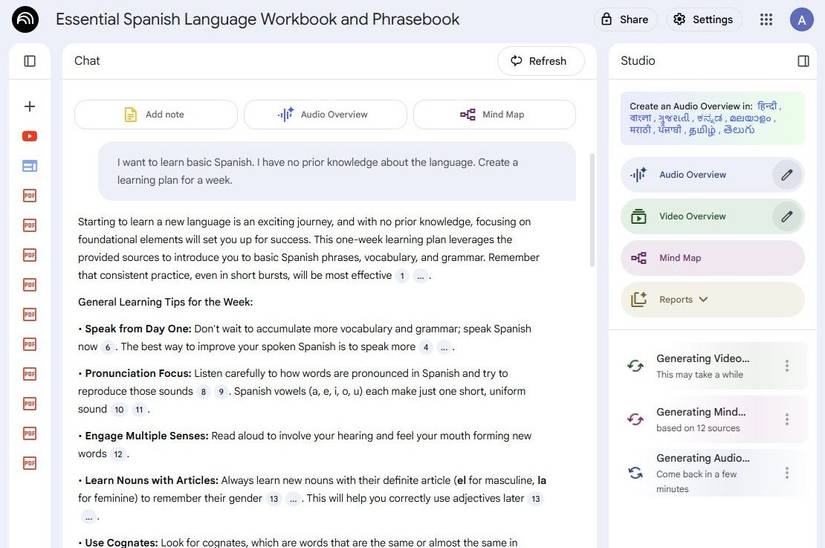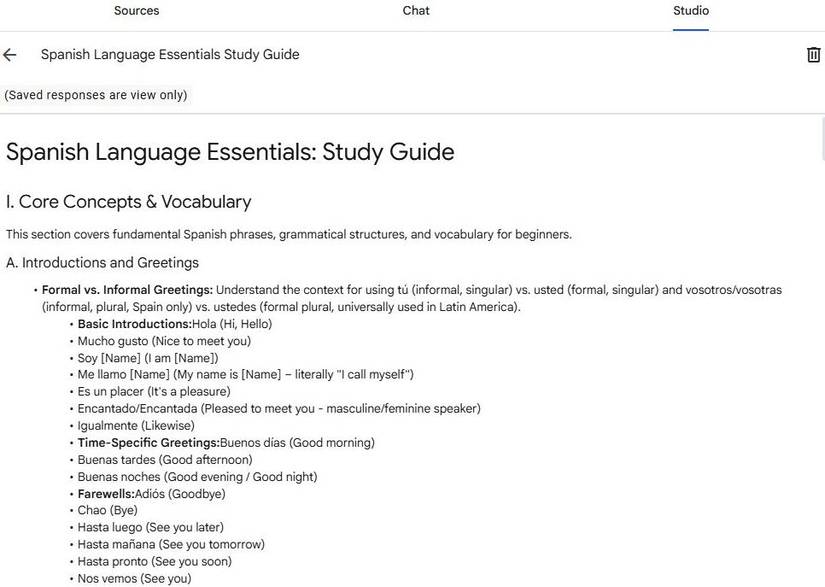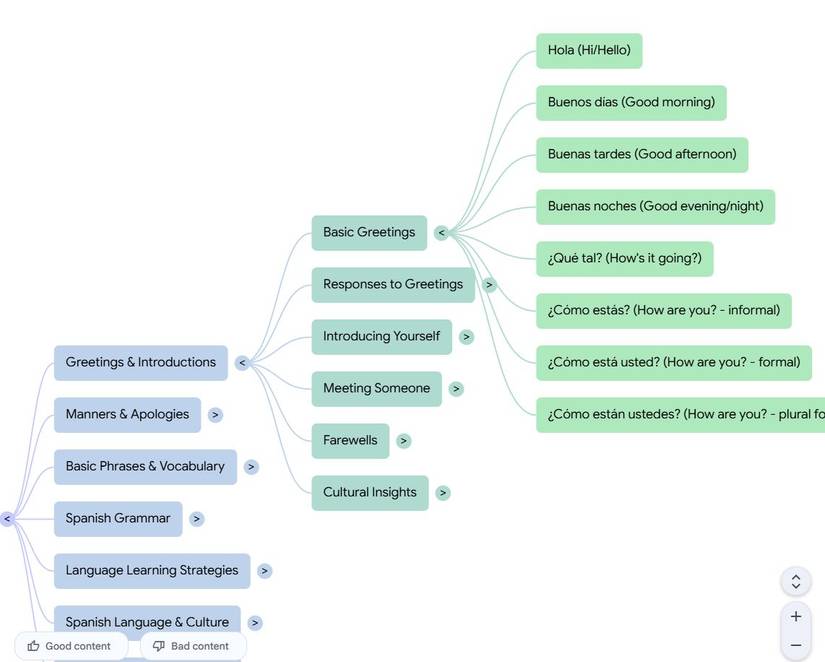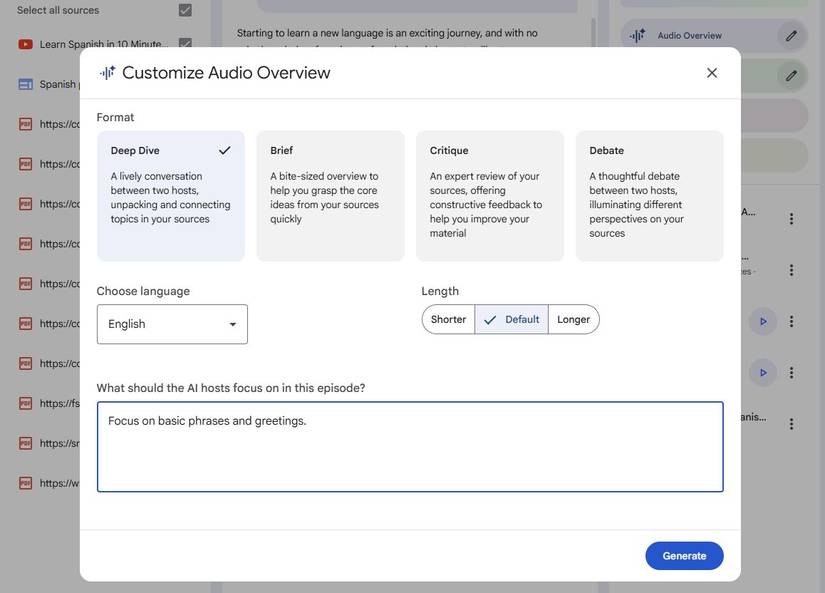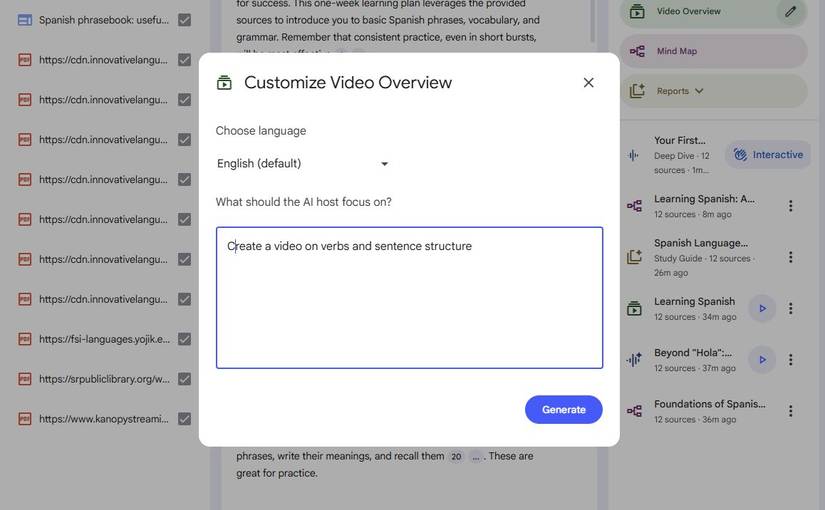Learning a new language has always been on my list of goals to tackle someday.
I’ve picked up textbooks, downloaded apps on my phone, and watched a few Spanish shows with subtitles. But nothing ever stuck due to my scattershot approach.
This time, I decided to try something different. I wanted structure, guidance, and the ability to see progress clearly.
So, I turned to NotebookLM and let it act as my Spanish tutor for an entire week to see what I could actually learn.
Setting up my AI-powered tutor
Creating a learning plan
Getting started with NotebookLM as a language tutor was surprisingly simple. Instead of downloading another app or signing up for a separate platform, all I had to do was feed it the material I wanted to learn from.
I uploaded a mix of Spanish resources, including beginner guides, grammar charts, and YouTube videos.
After gathering the learning materials, I asked it to create a learning plan for a week.
NotebookLM organized my notes into daily lessons, starting with greetings, numbers, and simple phrases.
It suggested exercises for translating sentences, practicing pronunciation, and even short quizzes.
Here’s how it structured my study plan for the week:
- Day one: Basic phrases and greetings
- Day two: Numbers, time, and essential questions
- Day three: Verbs and sentence structure
- Day four: Conversational practice
- Day five: Reading and comprehension
- Day six: Writing practice
- Day seven: Reflection and testing myself
Turning notes into a study guide
For quick review
One of the most handy tools NotebookLM offered was its built-in study guide. Instead of flipping through notes or re-reading transcripts, it pulled everything I’d been working on into a structured review document.
It highlighted key vocabulary words, broke them down with definitions and example sentences, and even grouped them by theme. For grammar, it included short explanations of the rules.
The study guide also featured a quick quiz and answer keys that I could skim through on my phone when I had a few minutes.
Visualizing connections with the Mind Map feature
It gave me a better perspective
NotebookLM’s Mind Map feature came in handy when I was feeling overwhelmed by the new words and phrases I had to learn. With a single click, it turned my notes into a web of connected concepts.
Instead of a long list of words or grammar points, I could see Greetings & Introductions branching out into Basic Greetings, Responses, Introducing Yourself, Farewells, and Cultural Insights.
Even verb conjugations looked less intimidating when laid out as a visual tree, showing how different tenses related to one another.
This bird’s-eye view helped me spot patterns I might have missed otherwise.
Learning on the go with Audio Overview
Making studying a part of my routine
One of the most unexpected features I relied on during the week was NotebookLM’s Audio Overview. With a single click, it transformed my study notes into a podcast I could listen to anywhere.
I’d customize my Audio Overview for each day. For instance, on day one, I asked it to focus on basic phrases and greetings.
I would queue up my audio notes before heading out for a walk, and language practice slipped naturally into my daily routine. It also gave me a chance to practice listening comprehension.
It wasn’t perfect. The audio lacked the nuance of a real language teacher’s intonation, and it didn’t quiz me back. But as a reinforcement tool, it was incredibly effective.
Turning lessons into mini-lectures with Video Overview
Perfect for visual learners
NotebookLM’s Video Overview was where my study notes really came alive.
Instead of staring at static text, I could generate a short video that walked through the key points of my Spanish notes.
The format made a big difference. Visuals, captions, and pacing helped break down the material in a way that felt more engaging than re-reading a study guide.
When I asked it to create a video on verbs and sentence structure, the result was a clear explanation of how subject–verb agreement works and how to start stringing together simple sentences.
I also found this feature beneficial for variety. After several days of studying text-heavy materials, switching to a video overview kept things fresh and less monotonous.
NotebookLM gave me the structure I was missing
A week of using NotebookLM as my Spanish tutor taught me more than I expected. It showed me that AI can make learning a new language feel intuitive and personalized.
While I’m far from fluent, I now have a foundation to continue learning, and I feel confident practicing, reading, and engaging in simple conversations.
NotebookLM turned what felt like an impossible week-long goal into a tangible achievement.
The variety kept me engaged, and the ability to request focused lessons (like verbs and sentence structure) made the learning feel tailored.
It’s not a replacement for real conversation practice or immersion, but it was surprisingly effective as a structured, always-available tutor on my phone.


